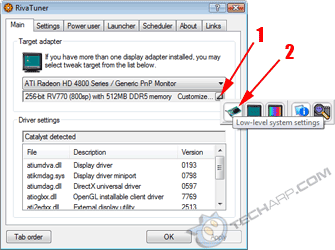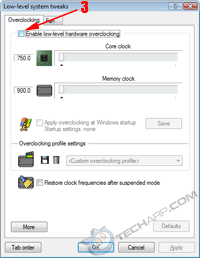Using RivaTuner
Unwinder's RivaTuner tool is a very nice, useful piece of software. From version 2.10 onwards, RivaTuner supports the AMD RV770 GPU that is used in the ATI Radeon HD 4800 series of graphics cards. You can get the latest version here.
After installing and loading it, you will see the following screen. You should see your card listed there. In this example, it's listed as the ATI Radeon HD 4800 Series. Below that, you will see that it detected the GPU (RV770) and the memory type and size (512MB DDR5).
- Click on the tiny button next to the Customize.. label. That will load a line of 5 icons. If you hover the mouse cursor over the first icon, a Low-level system settings label will appear.
- Click on that first icon. This will load up the Low-level system tweaks page.
- The Overclocking tab will be displayed by default. Click on the Enable low-level hardware overclocking checkbox.
 |
 |
- A small window will pop up, announcing that a reboot is recommended. If you are sure that you did not overclock the card prior to using RivaTuner, you can click Detect now to immediately detect the clock speeds. Otherwise, click Reboot to allow RivaTuner to reboot the computer for a proper detection of the graphics card's default clock speeds.
- After detecting the default clock speeds, you can adjust the core (GPU) and memory clock speeds by moving their sliders. Then click Apply or OK to activate the new settings.
- If you want the new clock settings to apply everytime the computer boots up, tick the Apply overclocking at Windows startup checkbox, and click Save.
Overclocking The RivaTuner Way
Irrespective of the overclocking tool used, it is never a good idea to overclock both the core and memory bus simultaneously. Doing so makes it almost impossible to pinpoint the cause when the overclock fails. So, always overclock one component at a time. Choose either the GPU or the memory clock. It doesn't matter which you choose.
Let's start with the memory clock. Overclock it in small steps. We tested our card in steps of 10-15 MHz. After selecting the new memory clock speed, click Apply. RivaTuner will immediately set the Radeon HD 4870's memory clock to the new clock speed.
Once you set the new memory clock speed, test it out using a real 3D game like Unreal Tournament 3 or Crysis. When you test the card out, be sure to note any visual abnormalities like corrupted textures. The game may even hang. This is a sign that one or more of the memory chips are failing at that clock speed. When that happens, reduce the memory clock by 5-10 MHz.
If the game runs well, you can increase the memory speed by an additional 10 MHz. Keep doing this until you discover the highest clock speed where your Radeon HD 4870 memory chips are stable. For added stability (in case of temperature or voltage changes), you might want to downclock by 10 to 20 MHz.
Once you have pegged the best clock speed for your memory chips, it's time to overclock the GPU. Restore the memory clock to its default setting and repeat the same steps as above for the GPU. We tested our card in steps of 10-15 MHz. After selecting the new GPU clock speed, click Apply.
Again, you should test out the overclock using a real 3D game like Unreal Tournament 3 or Crysis. Look for visual abnormalities in the game. Sometimes, the game may stall with the monitor blanking out for a moment. This is a sign that the GPU is running too hot and the graphics driver is attempting to recover. Usually, it succeeds and the game resumes. When this happens, clock down the GPU.
If the game runs well, clock up the GPU by another 10 MHz. Keep doing this until you discover the highest clock speed at which the GPU is stable. For added stability (in case of temperature or voltage changes), it would be a good idea to reduce the GPU clock by 10-20 MHz.
Finally, it's time to overclock both the GPU and the memory clock. Ramp both up to their maximum stable clock speeds and repeat the test with a real 3D game. If everything goes well, the game should run well without crashing or displaying corrupted textures. That's it! You have successfully overclocked your Radeon HD 4870 using RivaTuner!
The Tech ARP 2008 Graphics Card Giveaway Contest!
From October 4 until December 28, we are giving away 8 graphics cards and 32 exclusive Tech ARP t-shirts! To win one (or more) of these prizes, be sure to check out the Tech ARP 2008 Graphics Card Giveaway Contest!
Support Tech ARP!
If you like our work, you can help support out work by visiting our sponsors, participate in the Tech ARP Forums, or even donate to our fund. Any help you can render is greatly appreciated!
<<< The AMD GPU Clock Tool, Overclocking The AMD Gpu Clock Tool Way : Previous Page | Next Page : How Well Did We Do?, Testing The Overclocked Radeon HD 4870 >>>







 Add to Reddit
Add to Reddit


